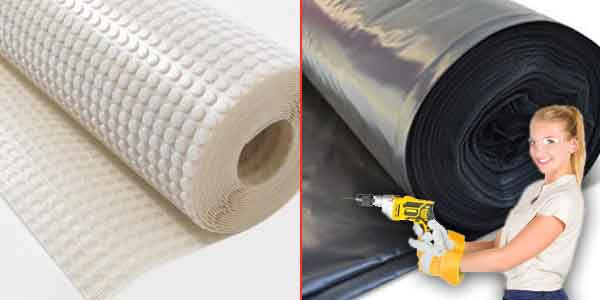The DIY Fix is reader supported. When you buy after clicking a link on our site, we may earn an affiliate commission.
A damp proof membrane is integral to many different structures. The membrane provides a completely waterproof barrier to stop the flow of moisture from the ground below. A membrane will commonly be used as part of a properties foundations and are usually placed beneath concrete slabs, or under floor screeds.
There are also damp proof membranes that can be used on walls in tanking systems. These are commonly used for damp proofing in high moisture areas, such as tanking a cellar.
Drilling through a damp proof membrane (DPM) will damage its integrity. By puncturing holes in the surface, you break the damp proof seal that it provides. However, there are situations where you may need to drill through.
If you do need to drill a hole in DPM, you must make sure that you seal the hole properly to make the membrane watertight again. This can often be done using a waterproof sealant such as silicone.

Fixing sole plate through DPM
One situation where you may need to drill through a damp proof membrane is when installing a stud partition wall. In most cases, you will need to screw the sole plate to the floor to stop the base of the wall from moving and flexing.
This is vitally important, especially if you intend to plaster the wall. Once your wall is fitted and fully plastered movement is likely to cause cracks to form in your plaster.
So, the question is, how can you fix the bottom of your wall without destroying the integrity of the membrane below it? Below you can see a couple of potential solutions:
Fixing a small stud wall
There are many reasons you could be building stud work. This could include everything from, Installing every internal wall in a property. To much smaller jobs like filling an old door opening.
If you wall is small and there is the possibility to fix into solid walls either side. There is a chance you could avoid the need to drill and fix with screws. Instead, you could fix your stud-work to the surrounding walls and not the floor.
However, there is still a risk that the bottom could move. To avoid this, there are two more things you can do. Firstly, make sure that your wall is tight from floor to ceiling, this will help to hold it in place and reduce movement. Secondly use no nail’s adhesive. This combination should do enough to hold the wall in place.
Solution for bigger walls
If your stud wall is bigger, it is more likely to move when not fixed correctly. In this situation a no nails adhesive is probably not going to be adequate. Some people might risk it. However, it is a gamble and adding fixings once the wall is plastered and decorated is going to be a real hassle.
In this scenario you will need to add fixings to create a solid base for your wall that can’t be moved. To do this you need to make sure that holes you do create remain sealed and won’t allow water to penetrate through damage caused to the DPM.
The way to do this is using a waterproof sealant or adhesive. A good option here is silicone. Before you fix your sole plate, drill the holes, and add silicone sealant around the hole. Also add silicone into the drill hole.
Now you can fix your sole plate with plugs and screws in the normal fashion and any moisture will be completely contained due to the silicone sealant. If this is done properly there is no chance of damp penetrating through
Drilling through a wall membrane
A damp proof membrane added to a wall (also known as a tanking membrane) is a perfect example of a membrane that is drilled and fixed to a surface to install it.
These tanking systems will usually have a fixing every 250-300mm in every direction. Therefore, an entire wall or room could have hundreds of fixings. Every one of these fixings. is a breach of the damp proof membrane. However, the fixings they use create a new seal.
The fixing plug is used in combination with a sealing washer and a mastic sealant. This means that the hole is completely sealed and provides a strong fixing for the membrane. So much so that you are now able to dot and dab plasterboard directly onto the tanking membrane.
So, it is strong and well fixed, but also completely resistant to penetrating damp.
A damp proof membrane used for wall tanking, is a completely different product to the one used below a concrete slab.
If you look at them side by side, they look very different. This is simply because they are designed for different purposed. However, in theory you could us wall tanking on a floor (and some people do). The main point here is they are both designed to do the exact same thing and that is stop damp penetrating through to internal surfaces.
Therefore, if you can add hundreds of drill holes to a tanking membrane and then effectively seal it. There is no reason you couldn’t do the same when fixing the sole plate of a stud wall.
Conclusion
As you can see it is acceptable to drill through a DPM. However, you should only do this if it is completely necessary. It is also very important that you seal the hole properly. If you don’t seal the hole, you run the risk of damp penetrating through. When in doubt, always talk to a professional. If it is a big job, then you should compare quotes online. Doing this can save you a considerable amount of money. You can see our favourite trade comparison service by clicking here


